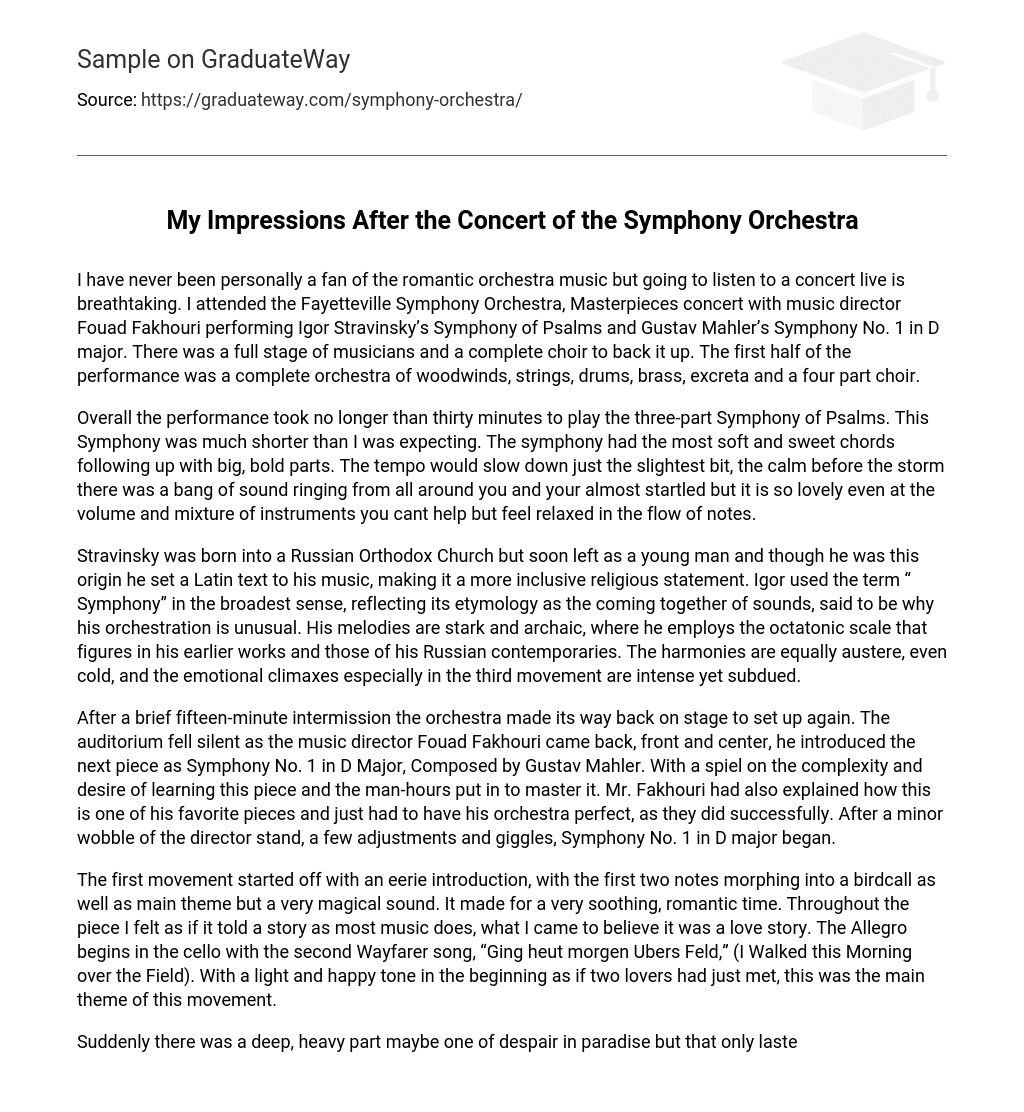Although I have never been a fan of romantic orchestra music, attending a live concert is truly awe-inspiring. Recently, I had the opportunity to experience the Fayetteville Symphony Orchestra’s Masterpieces concert, which was conducted by music director Fouad Fakhouri. The concert featured phenomenal renditions of Igor Stravinsky’s Symphony of Psalms and Gustav Mahler’s Symphony No. 1 in D major. The stage was filled with exceptionally talented musicians who were accompanied by a full choir. During the first half of the performance, an array of instruments including woodwinds, strings, drums, brass, and more were showcased along with a four part choir.
In summary, the Symphony of Psalms consisted of three parts and lasted less than thirty minutes, which was shorter than expected. The symphony included both gentle and melodic chords and strong and intense sections. At times, the tempo would relax a bit, creating a peaceful ambiance before a sudden explosion of sound filled the air. Despite its loudness and variety of instruments used, the performance was enjoyable and calming, providing an opportunity to unwind and fully engage with the musical arrangement.
Stravinsky, born into a Russian Orthodox Church, soon departed from this background. Despite his origins, he opted to incorporate a Latin text into his music, creating a more inclusive religious expression. Igor’s interpretation of “Symphony” extended its meaning to encompass a variety of sounds, aligning with its etymology. This is why his orchestration is distinct. His melodies are plain and antiquated, featuring the octatonic scale that was prominent in his earlier compositions and those of his Russian contemporaries. The harmonies are equally severe and even chilly, especially apparent during the emotional climaxes in the third movement, which although intense, remain subdued.
After a brief fifteen-minute intermission, the orchestra returned to the stage to set up again. The auditorium became quiet as the music director, Fouad Fakhouri, returned to the front and center. He introduced the next piece as Symphony No. 1 in D Major, composed by Gustav Mahler. Fakhouri spoke about the complexity and effort required to learn and master this piece, expressing his passion for it. He also mentioned the importance of perfection for his orchestra, which they successfully achieved. After some minor adjustments and laughter caused by a slight wobble of the director stand, Symphony No. 1 in D major began.
The initial part started with a haunting introduction where the first two notes transformed into a birdcall, accompanied by the main theme with a hint of magic. This created a soothing and romantic atmosphere. Throughout the composition, I perceived it as a narrative, similar to most music, and concluded that it told a love story. The Allegro section initiated in the cello, featuring the second Wayfarer song titled “Ging heut morgen Ubers Feld” (I Walked this Morning over the Field). The movement began with a light and joyous tone, resembling the encounter of two lovers, and this melody served as the central theme in this segment.
Suddenly, paradise was filled with a strong sense of despair, but this feeling was short-lived and ended triumphantly with a happily ever after (Kahn). The second movement, known as the Scherzo, portrays an elegant atmosphere reminiscent of a royal ball. Women adorned in beautiful gowns and men in tuxedos dance and enjoy themselves to the melodic sounds. The rhythm of this movement resembles that of the Landler, an Australian folk dance. It adheres to the traditional minuet and trio structure, although Mahler expands the first section beyond the usual repeat format. Additionally, the initial three notes in both the Scherzo and the Trio bring to mind the birdcall theme found in the first movement.
The third movement of the piece had a tribal feel due to the inclusion of percussion, drums, and symbols. It was a bold section that overshadowed the other instruments at that moment. This movement is a funeral march based on the nursery rhyme “Frere Jacques” in a minor key. The theme then transitions to the fourth song of “Wayfarer,” titled “Die zwei blauen Augen von meinem Schatz” (My Sweetheart’s Two Blue Eyes), which has a hypnotic and calming quality. Lastly, the piece concludes with a dance that incorporates elements of Jewish Klezmer music.
The stormy Finale starts with a threatening passage in classical music and continues in the main body of the Allegro. According to the program, the ending is described as big but it is an understatement considering how it made me jump out of my seat when it started. It is a powerful and brilliant finale that I definitely did not expect. Mahler connects themes in this Finale to create a gentle and comforting theme. The resolution happens in a heroic coda, with a triumphant reprise of the distant fanfare from the Symphony’s opening.
Although the event was mandatory, I was thrilled that I decided to attend because it turned out to be an incredible experience. I am eagerly anticipating the next one in a few weeks. The choir gave an exceptional performance and the orchestra consisted of both young and older musicians who worked together flawlessly to create a night that will never be forgotten. Through their hard work, they reintroduced overlooked music to a larger crowd and shed new light on it.





